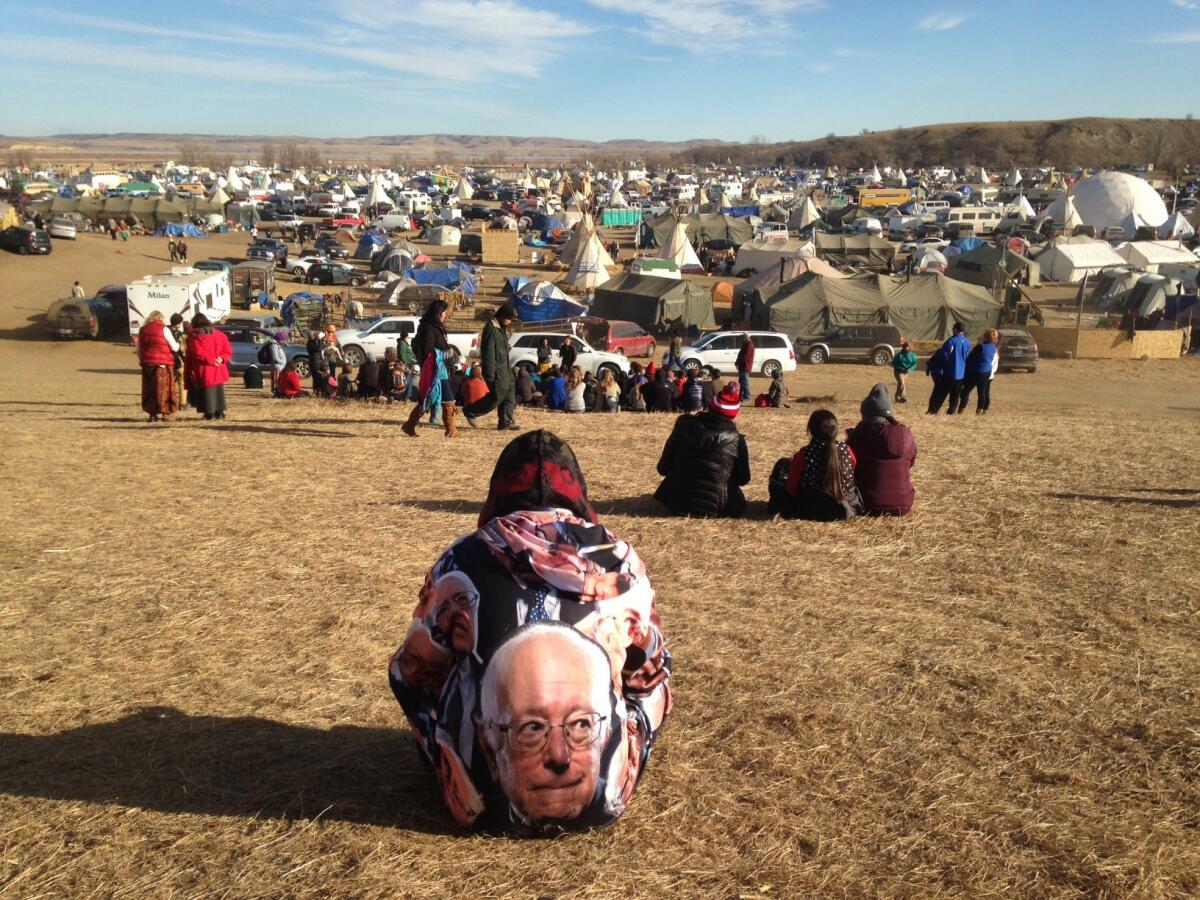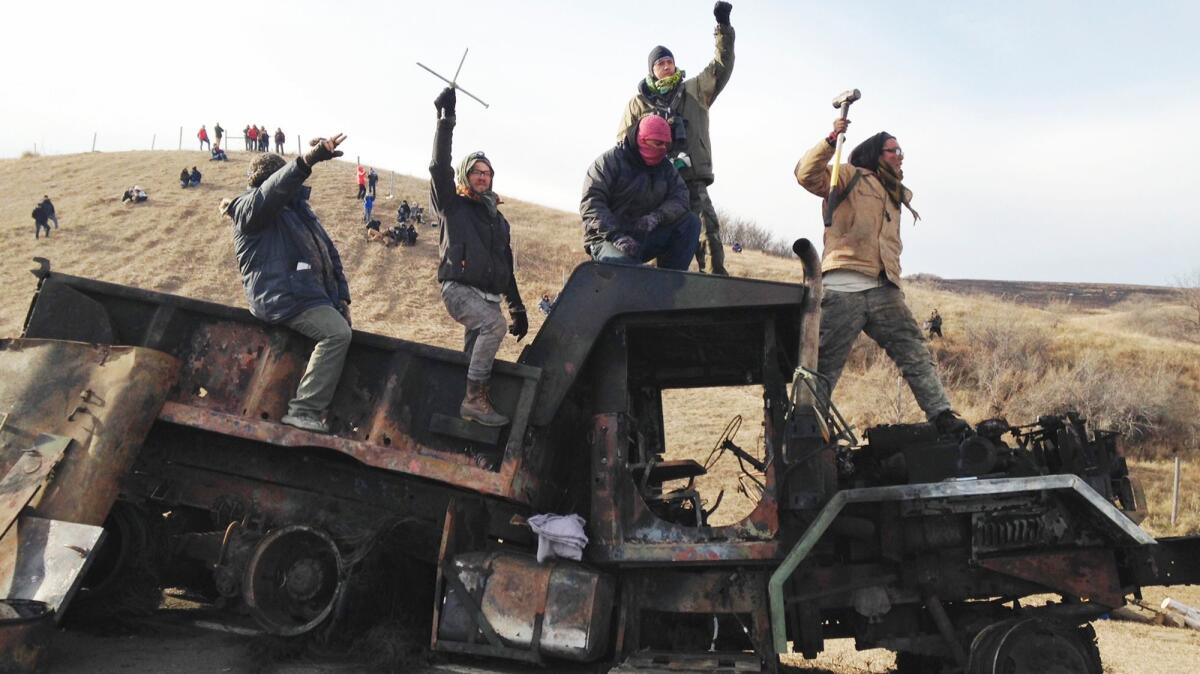North Dakota governor orders evacuation of Standing Rock protest site, but no forcible removals planned

- Share via
North Dakota Gov. Jack Dalrymple on Monday ordered a mandatory evacuation of protesters seeking to block construction of the Dakota Access pipeline, but both the state and the U.S. Army Corps of Engineers said they have no plans for “forcible removal” of the protesters.
The Corps of Engineers earlier had said that it planned to close the camp, led by the Standing Rock Sioux tribe of North Dakota, by Dec. 5, and that anyone still there could be prosecuted for trespassing.
On Sunday, however, after a broad backlash, the corps said it has “no plans for forcible removal” and “is seeking a peaceful and orderly transition to a safer location.”
Dalrymple’s evacuation order came Monday, citing safety concerns related to the region’s harsh winter weather.
In an emergency declaration, the governor, a Republican who has urged federal officials to allow completion of the pipeline, said the camp is “not zoned for dwellings suitable for living in winter conditions, and also [does] not possess proper permanent sanitation infrastructure to sustain a living environment consistent with proper public health.”
The governor referred to safety concerns stated by the corps and “the inability to effectively provide emergency, medical, fire response services, and law enforcement services.”
But though the order said people who defy it could face legal consequences, officials said the state also would not seek to forcibly remove people.
“It’s part of our due diligence. These folks out there have to understand the situation. We’ve got folks from all over the country out there and I don’t know what they know about North Dakota winters,” Jeff Zent, a spokesman for the governor, said.
“Today we got dumped about 5 inches of snow. I’m sure conditions are not good out there. This order lets them know the situation in no uncertain terms,” he added.
The corps said Sunday that groups that were not part of the original protest of the pipeline helped shape its decision to try to close the camp.
“Unfortunately, it is apparent that more dangerous groups have joined this protest and are provoking conflict in spite of the public pleas from tribal leaders,” said Col. John Henderson, the commander of the corps’ Omaha district. We are working to transition those engaged in peaceful protest from this area and enable law enforcement authorities to address violent or illegal acts as appropriate to protect public safety.”

The corps, which has allowed the camp to grow for months, had said “safety reasons” prompted the notice on Friday. More than 500 people have been arrested since the summer in sometimes violent clashes with local law enforcement, which has come under fierce criticism for what protesters say have been abusive tactics.
The notice prompted an array of criticisms and vows by protesters and their supporters to stay. Some noted that it came just a day after Thanksgiving, a holiday associated with oppression for many Native Americans, though it is also portrayed as symbolic of goodwill with European settlers. Others pointed out that Dec. 5 is the birthday of Gen. George Armstrong Custer, who famously clashed with Native Americans.
On Monday morning, Dallas Goldtooth, a leader of the Indigenous Environmental Network, posted a video showing snow falling outside the yurt in which he was camping at the site.
“We don’t expect a forced removal or a sweep ... of this camp relatively soon based on their words,” Goldtooth said, referring to the Sunday night clarification. “But we as a camp are prepared, are preparing, for any scenario for the protection and safety of our folks.
“In the meantime, shout out to all of you lovely people out there, rabble rousers, pipeline fighters. Let’s keep fossil fuels in the ground. Talk to you later. Peace. I’m going sledding later on.”
The Standing Rock Sioux tribe has argued for months that the pipeline will put its water supply and cultural sites at risk. The corps announced this month that it would continue to withhold a final permit for the pipeline while it conducts additional analysis of the project and expands consultation with the tribe.
The corps said the additional review was “warranted in light of the history of the Great Sioux Nation’s dispossession of lands, the importance of Lake Oahe to the Tribe, our government-to-government relationship, and the statute governing easements through government property.”
The company building the pipeline, Energy Transfer Partners, has said that the Obama administration made the pipeline a political issue and that it has filed suit in federal court asking to proceed with the project.
The 1,170-mile pipeline would transport as much 500,000 barrels of crude oil daily from the Bakken production region of North Dakota to an existing pipeline in Patoka, Ill.
ALSO
Obama administration bans Arctic offshore oil drilling through 2022. But will Trump reverse it?
There’s a reason few even knew the Dakota Access pipeline was being built
UPDATES:
4:45 p.m.: This story was updated with a statement from the North Dakota governor ordering an evacuation of the Standing Rock protest camp.
This story was originally published at 1:10 p.m.
More to Read
Sign up for Essential California
The most important California stories and recommendations in your inbox every morning.
You may occasionally receive promotional content from the Los Angeles Times.











